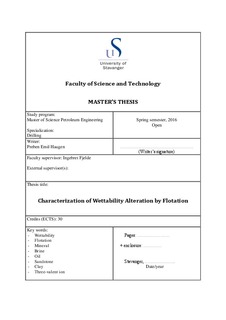| dc.contributor.author | Haugen, Preben Emil | |
| dc.date.accessioned | 2016-09-20T13:36:34Z | |
| dc.date.available | 2016-09-20T13:36:34Z | |
| dc.date.issued | 2016-06 | |
| dc.identifier.uri | http://hdl.handle.net/11250/2408852 | |
| dc.description | Master's thesis in Petroleum engineering | nb_NO |
| dc.description.abstract | A study in how wettability is altered by different brine/oil combnations | nb_NO |
| dc.description.abstract | Master's thesis in Petroleum engineering:
Alterations in reservoir wettability are known to affect the oil production (1,2). The exact causes of alteration, and how much each of these causes alter wettability is what this study intends to examine. The flotation method was used to examine how different brine and oil combinations affect the wettability of different sandstone minerals, and a rock from a clay rich sandstone reservoir in the North Sea. A total of 238 different samples were made to examine the effect all possible combinations of the following variables have on wettability: - oils: three different stock tank oils (STO) from North Sea reservoirs, and N-decane - brines: synthetic formation water (FW) from two North Sea reservoirs, synthetic sea water (SW) and low salinity water (LSW) - minerals: quartz, K-feldspar, glauconite, muscovite and rock from a North Sea reservoir In addition to this a few glauconite samples were prepared with a low concentration of threevalent Iron and Aluminum cations in the brine to examine how they affect wettability. Quartz was found to be near 100% water-wet for all brine/oil combinations. Kfeldspar, glauconite and rock from field #1 was found to primarily water-wet (>80% waterwet) for all brine/oil combinations. Muscovite showed both water-wet and oil-wet tendencies, depending on the brine/oil combination. LSW came back with the most water-wet results, compared to the other brines, while samples aged in SW came back with similar wetting results as FW #1 and FW #2 in most cases. The wettability results showed a clear correlation between the total acid number (TAN) of the oil and the Ca2+ concentration of the brine for all minerals except quartz. Samples aged in an oil with high TAN are more sensitive to the Ca2+ concentration of the brine, than samples aged in an oil with low TAN. If the samples are aged in a brine with a high Ca2+ concentration, the wettability is more sensitive to the TAN of the oil than if aged in a brine with a low Ca2+ concentration. Fe3+ and Al3+ appears to have a similar effect as Ca2+, only the effect can be observed at much lower concentrations. | nb_NO |
| dc.language.iso | eng | nb_NO |
| dc.publisher | University of Stavanger, Norway | nb_NO |
| dc.relation.ispartofseries | Masteroppgave/UIS-TN-IPT/2016; | |
| dc.rights | Navngivelse 3.0 Norge | * |
| dc.rights.uri | http://creativecommons.org/licenses/by/3.0/no/ | * |
| dc.subject | petroleumsteknologi | nb_NO |
| dc.subject | petroleum engineering | nb_NO |
| dc.subject | reservoarteknologi | nb_NO |
| dc.subject | wettability | nb_NO |
| dc.subject | flotation | nb_NO |
| dc.subject | mineral | nb_NO |
| dc.subject | brine | nb_NO |
| dc.subject | oil | nb_NO |
| dc.title | Characterization of Wettability Alteration by Flotation | nb_NO |
| dc.type | Master thesis | nb_NO |
| dc.subject.nsi | VDP::Technology: 500::Rock and petroleum disciplines: 510::Petroleum engineering: 512 | nb_NO |

